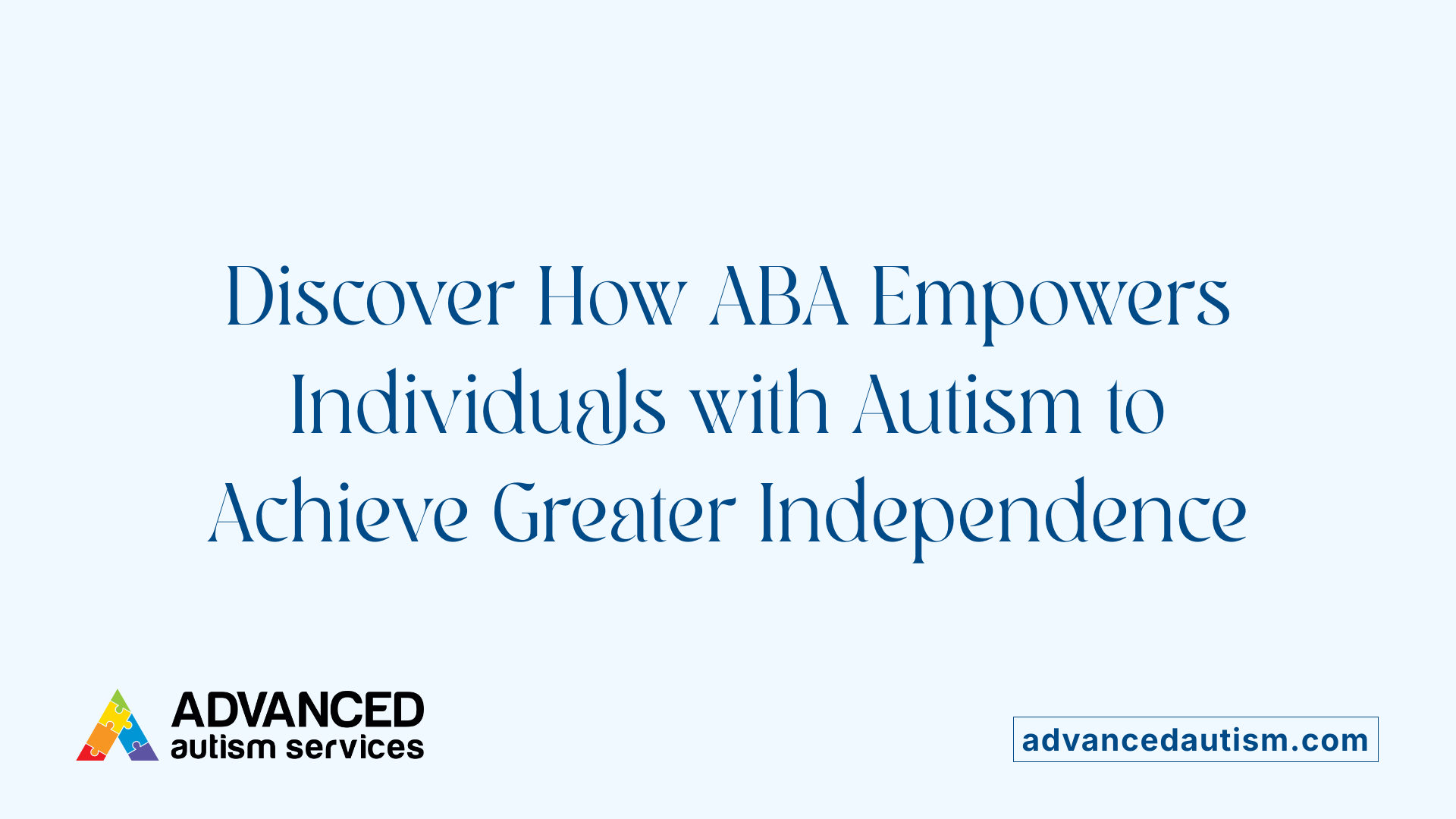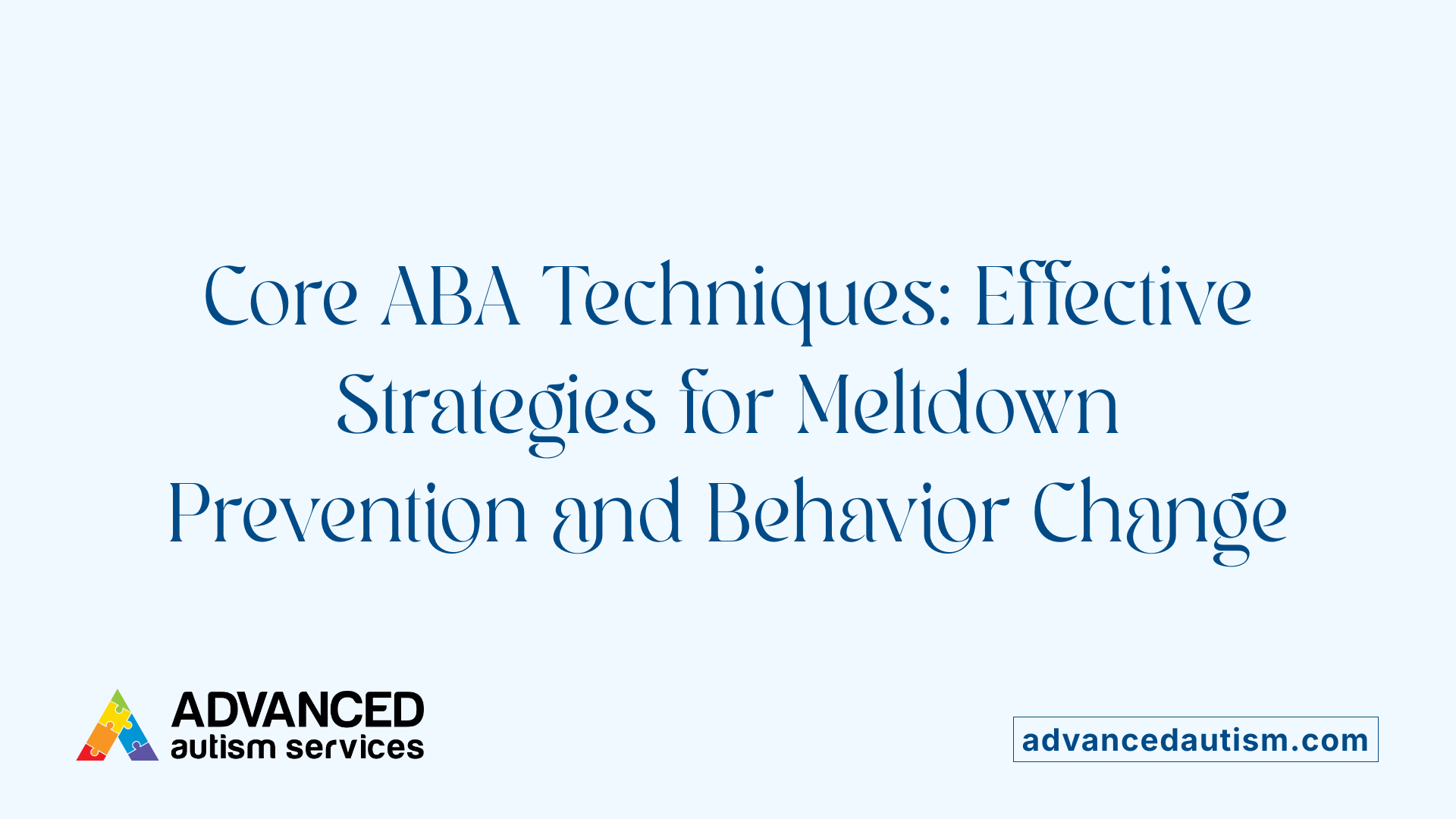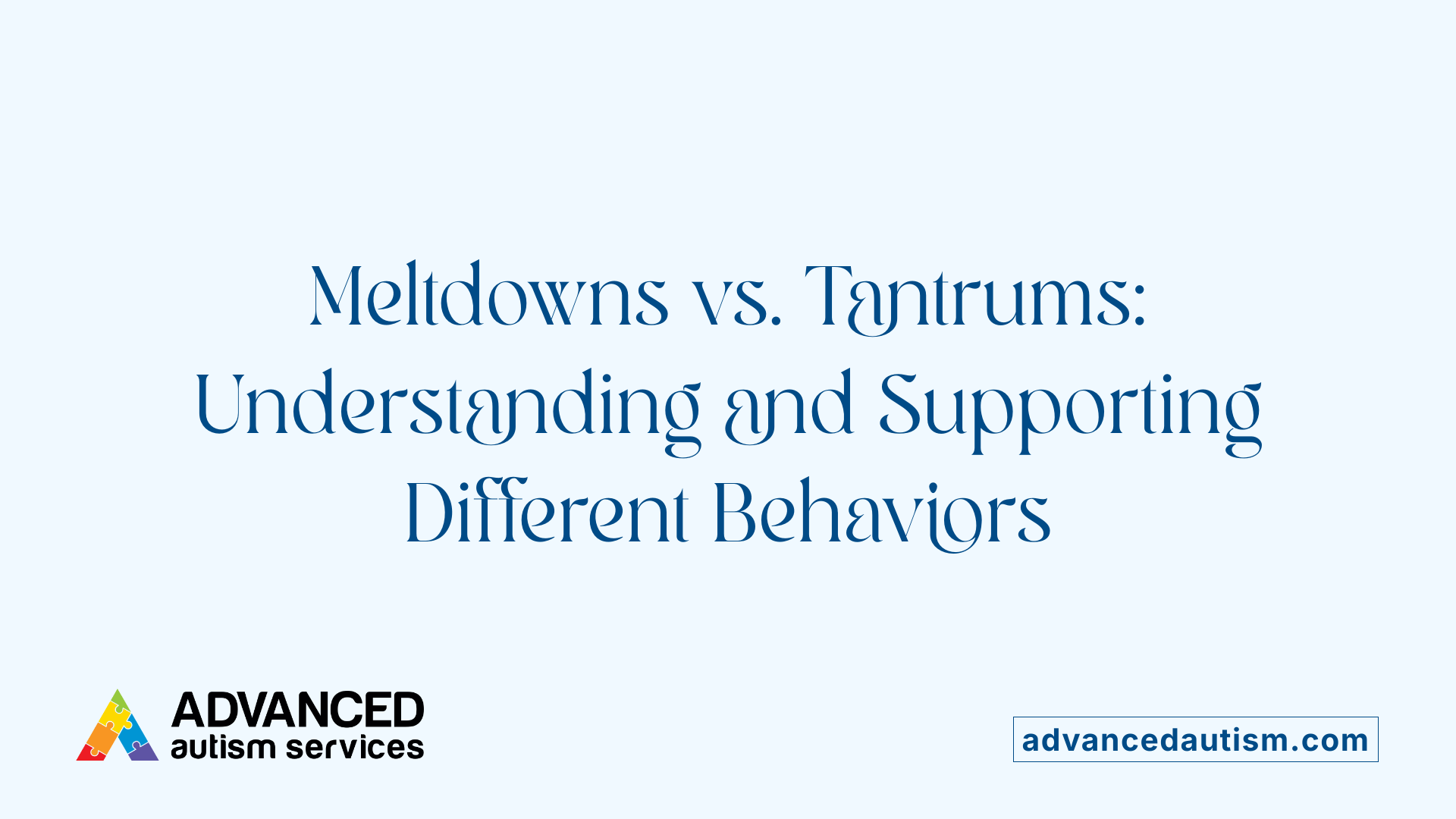The Challenge of Autism Meltdowns
Autism meltdowns can be overwhelming for individuals and caregivers alike. These intense emotional reactions stem from sensory overload, changes in routine, or communication frustrations rather than willful misbehavior. Understanding the nature of meltdowns and employing evidence-based strategies is crucial for prevention and effective management. Applied Behavior Analysis (ABA) therapy offers a scientifically supported, individualized approach to help identify triggers, teach coping skills, and create supportive environments to reduce and handle meltdowns.
What Is Applied Behavior Analysis (ABA) Therapy?

What is applied behavior analysis (ABA) therapy?
Applied Behavior Analysis (ABA) therapy is a scientifically supported, evidence-based practice designed to promote meaningful behavioral changes. It focuses on improving socially significant skills, particularly for individuals with autism spectrum disorder (ASD). ABA involves careful observation and assessment of behaviors to develop individualized treatment plans. These plans target the enhancement of communication, social interaction, and daily living skills, while aiming to reduce challenging or harmful behaviors.
ABA therapy uses data-driven decisions to monitor progress and adjust interventions as needed. It is typically delivered one-on-one by trained professionals, such as Board Certified Behavior Analysts (BCBAs). The approach is adaptable, applying across various environments including clinical centers, homes, and schools, ensuring consistency and reinforcement of learned behaviors.
Core techniques used in ABA therapy
Several foundational techniques form the backbone of ABA therapy:
- Positive Reinforcement: Rewarding desired behaviors to increase their frequency.
- Behavior Chaining: Breaking down complex tasks into smaller, teachable steps.
- Modeling: Demonstrating desired behaviors for learning through observation.
- Prompting and Fading: Providing initial assistance and gradually reducing it to foster independence.
- Extinction: Reducing unwanted behaviors by withholding reinforcement.
- Redirection: Guiding individuals away from inappropriate behaviors toward positive ones.
- Script Fading: Practicing social scenarios with cues that are slowly removed to build autonomy.
These techniques are tailored to each individual’s strengths and needs, ensuring therapy is highly personalized.
Individualized treatment plans and settings
ABA therapy starts by closely analyzing behavior patterns, triggers, and consequences. This comprehensive assessment allows therapists to create customized interventions aimed at maximizing each person's abilities. The treatment plans emphasize family involvement to promote consistency and generalization of skills beyond therapy sessions.
Professionals deliver ABA in diverse settings such as clinics, homes, and educational environments. This versatility helps address challenges in real-world contexts, making progress more sustainable and meaningful for individuals.
Overall, ABA therapy stands as an effective, data-driven, and compassionate method to support individuals with developmental challenges in achieving greater independence and improved quality of life.
How ABA Therapy Benefits Individuals with Autism

How does ABA therapy benefit individuals with autism?
Applied Behavior Analysis (ABA) therapy is a powerful tool designed to help individuals with autism develop essential skills and reduce challenging behaviors. It accomplishes this through personalized programs that teach new abilities in communication, social interaction, self-care, and academic tasks. By focusing on positive reinforcement, ABA encourages repetition of desired behaviors, boosting independence and social success.
Skill development in communication and self-care
ABA techniques help teach critical communication skills tailored to each individual's needs, such as verbal behavior interventions and functional communication training. This support extends to daily living activities, guiding individuals to gain self-care skills like dressing, eating, and hygiene through structured approaches such as behavior chaining.
Reduction of problematic behaviors
ABA therapy identifies triggers for challenging behaviors commonly seen in autism and uses methods like extinction, redirection, and antecedent manipulation to reduce these behaviors. By reinforcing appropriate behavior and withholding reinforcement for unwanted actions, ABA promotes more positive interactions and fewer behavioral disruptions.
Personalized programs
Each ABA program is uniquely designed by behavior analysts after thorough observation and data collection. This ensures interventions address specific strengths, weaknesses, and goals, making therapy highly effective and relevant to the individual's life.
Early intensive intervention benefits
Starting ABA therapy early—sometimes as young as two years old—leverages the brain's plasticity during critical developmental stages. Early intensive behavioral intervention maximizes improvements in communication, social skills, and behavior management, facilitating smoother integration into various environments, including school.
Support for independence
By teaching skills through prompting and fading techniques, ABA gradually transitions individuals from assisted performance to independent functioning. Consistent family involvement and reinforcement across settings strengthen this process, empowering individuals with autism to achieve greater autonomy.
| Benefit Area | ABA Approach | Impact |
|---|---|---|
| Communication Skills | Verbal Behavior Intervention, Modeling | Improves expressive and receptive communication |
| Self-Care | Behavior Chaining, Prompting & Fading | Enhances independence in daily routines |
| Behavior Management | Extinction, Redirection, Reinforcement | Decreases problem behaviors, promotes positive ones |
| Early Intervention | Early Intensive Behavioral Intervention | Maximizes developmental gains |
| Personalization | Tailored Programs by Behavior Analysts | Addresses unique needs for effective outcomes |
| Independence | Prompting, Fading, Family Involvement | Builds self-reliance across different environments |
Providers of ABA Therapy: Professionals and Settings

Who Provides ABA Therapy?
ABA therapy is delivered by highly trained professionals committed to helping individuals develop essential skills and reduce challenging behaviors. The primary providers are Board Certified Behavior Analysts (BCBAs), who are responsible for designing, overseeing, and adjusting individualized treatment plans based on detailed behavioral observations and data analysis.
Roles of Registered Behavior Technicians (RBTs)
Supporting BCBAs, Registered Behavior Technicians (RBTs) play a crucial role by directly implementing therapy techniques with clients. Under BCBA supervision, RBTs apply interventions such as reinforcement strategies, behavior chaining, and prompting to encourage skill acquisition and behavior change.
Settings Offering ABA Therapy
ABA services are versatile and provided across multiple environments to fit client needs. These include:
- Clinical settings staffed by multidisciplinary teams
- Home environments, enabling therapy within daily routines
- School settings, facilitating social and academic skill development
- Community-based programs designed to promote generalization of skills in natural contexts
Importance of Caregiver and Family Involvement
Family members and caregivers are integral partners in ABA therapy. Training in techniques and behavior support empowers them to reinforce positive behaviors and create consistency across settings. Their active involvement enhances the effectiveness of interventions and promotes lasting behavioral improvements.
Community-Based Services
Many communities offer specialized ABA programs through local organizations and clinics. These services focus on blending therapy with real-life activities, helping individuals apply learned skills socially and functionally outside formal therapy sessions.
Together, these professionals and settings form a coordinated support system dedicated to delivering effective, personalized ABA therapy tailored to the unique requirements of each individual.
Core ABA Techniques Used in Meltdown Prevention and Behavior Modification

What methods are used in ABA therapy?
Applied Behavior Analysis (ABA) employs a variety of methods to modify behavior and promote learning. Central to ABA are techniques such as positive reinforcement, which rewards desired behaviors to encourage their recurrence, and negative reinforcement, which promotes behaviors by removing unpleasant stimuli. These strategies help increase adaptive behaviors effectively.
Prompting and fading support skill acquisition by initially providing assistance or cues and gradually reducing this help until the individual performs independently. This is especially useful in teaching new tasks or social skills.
Behavior chaining breaks down complex activities into smaller sequential steps, allowing individuals to master one step at a time. This method is practical when teaching multi-step routines or tasks.
Modeling, including visual modeling like video demonstrations and charts, provides clear examples of desired behaviors. Therapists demonstrate these behaviors, making it easier for learners, particularly autistic children, to understand and imitate appropriate actions.
Redirection guides individuals away from undesirable behaviors towards positive alternatives, while extinction involves withholding reinforcement to reduce challenging behaviors over time. Initial increases in behavior may occur during extinction before it decreases.
Script fading involves practicing social scripts with guided cues that are gradually removed, helping build social independence. Behavior contracts formalize expectations with clear rewards and consequences to shape behavior consistently.
Together, these ABA techniques create personalized, data-driven interventions that effectively support behavior modification and support during meltdowns or tantrums by addressing triggers and reinforcing positive responses.
Understanding Autism Meltdowns Versus Tantrums

What is the Difference Between Meltdowns and Tantrums?
Meltdowns and tantrums are often confused, but they involve fundamentally different behaviors. Tantrums are typically goal-oriented and controllable, where a child might act out to get attention or achieve a specific outcome. In contrast, meltdowns are overwhelming involuntary emotional responses triggered by sensory or emotional overload. They are not manipulative or deliberate but rather signs of distress.
Are Meltdowns Involuntary Emotional Responses?
Yes, meltdowns occur as intense emotional reactions when a child encounters situations like sensory overload, sudden changes in routine, or frustrations stemming from unmet needs. Unlike tantrums, which a child can stop when motivated, meltdowns are involuntary and often very difficult for the child to control.
What Triggers Meltdowns and Tantrums?
Both meltdowns and tantrums can be set off by triggers related to communication difficulties or environmental changes. However, meltdowns are more often triggered by sensory overload, such as loud noises or bright lights, and drastic routine disruptions. Tantrums may start from frustration or attempts to exert control. Recognizing these triggers is crucial for tailoring interventions.
Why Is It Important to Recognize This Distinction in Interventions?
Understanding the difference between meltdowns and tantrums allows caregivers and therapists to choose appropriate intervention strategies. For instance, ABA therapy focuses on antecedent manipulation and positive reinforcement during tantrums but emphasizes sensory-friendly environments, coping mechanisms, and calm de-escalation techniques for meltdowns. Recognizing whether a child is experiencing a meltdown or tantrum prevents misinterpreting behaviors and ensures compassionate and effective support.
Identifying and Managing Triggers to Prevent Meltdowns
What are common triggers for meltdowns in individuals with autism?
Meltdowns in autism often stem from sensory overload, unexpected changes in routine, and communication difficulties. Sensory overload happens when an individual is overwhelmed by sounds, lights, or textures. Changes to daily schedules can increase anxiety, as predictability is crucial for many autistic individuals. Communication challenges may lead to frustration and emotional distress, sometimes triggering meltdowns.
How can antecedent manipulation be used to reduce triggers?
Antecedent manipulation involves identifying environmental or situational triggers before a meltdown occurs and adjusting them strategically. This can include simplifying sensory input, offering choices to increase predictability, or gradually introducing new routines. Through careful observation and intervention, antecedent manipulation helps prevent severe reactions.
What role do sensory-friendly environments play?
Creating sensory-friendly spaces means minimizing overwhelming stimuli by controlling noise levels, lighting, and tactile sensations. These environments help individuals stay calm and focused, reducing the likelihood of sensory-related meltdowns.
How important are structured routines and schedules?
Structured routines provide predictability, which lessens anxiety and confusion. Implementing consistent schedules helps individuals anticipate what comes next, decreasing stress associated with uncertainty.
How can visual aids like timers and charts assist?
Visual aids such as timers, charts, and calendars offer clear visual cues about upcoming events and transitions. These tools enhance understanding and give individuals a sense of control, helping them manage expectations and prepare for routine changes.
Recognizing Early Warning Signs and Stages of Meltdowns
Early Signs Like Restlessness and Repetitive Behaviors
Before a meltdown occurs, individuals with autism spectrum disorder (ASD) often display early warning signs such as restlessness, increased repetitive behaviors, or heightened agitation. These subtle cues act as important indicators that emotional overload or sensory distress is building up.
Phases: Early Warning, Escalation, Recovery
Meltdowns typically progress through three distinct phases:
Early Warning Phase: The individual may become more withdrawn, restless, or engage in repetitive movements. Alertness to this phase allows for timely intervention.
Escalation Phase: The emotional response intensifies, potentially resulting in crying, yelling, or physical outbursts. At this stage, calming strategies are critical.
Recovery Phase: The distress diminishes, and the individual begins to regain composure and process the experience.
Tailoring Interventions for Each Stage
Intervention strategies must be adapted to the phase of the meltdown. Early warning signs warrant proactive measures such as offering a sensory-friendly environment or visual schedules to prevent escalation. During escalation, de-escalation techniques including calm communication and safe spaces help reduce distress. Post-meltdown, emotional support and reinforcing coping mechanisms facilitate recovery.
Benefits of Early Recognition in De-escalation
Recognizing early signs significantly improves the ability to intervene before the meltdown escalates. Timely identification enhances the effectiveness of strategies such as antecedent manipulation and structured routines, ultimately reducing the frequency and severity of meltdowns and fostering greater emotional regulation.
ABA Strategies for Meltdown Prevention and Management
What is antecedent manipulation and how does it help prevent meltdowns?
Antecedent manipulation in ABA involves identifying and modifying environmental triggers that may lead to challenging behaviors, including meltdowns. Examples include using visual timers, offering choices, or adjusting sensory inputs to reduce the odds of overwhelming situations. By proactively addressing these triggers, individuals are less likely to reach a state of emotional overload.
How is positive reinforcement used during calm behavior?
Positive reinforcement entails rewarding desired, calm behaviors to encourage their repetition. During periods of calm, caregivers and therapists might praise or provide small rewards to reinforce appropriate actions. In contrast, during meltdowns, reinforcement is often withheld to avoid inadvertently encouraging distress behaviors.
How do redirection and visual modeling assist in managing meltdowns?
Redirection guides individuals away from distressing stimuli toward positive or soothing activities, helping to disrupt escalation. Visual modeling, including video examples or charts, offers clear demonstrations of expected behaviors and coping strategies. These tools empower individuals, particularly autistic children, to understand and adopt appropriate responses during stressful moments.
What calm de-escalation techniques and safe spaces are recommended?
Calm de-escalation includes lowering voice volume, maintaining gentle body language, and providing a predictable, sensory-friendly environment. Safe spaces are designated quiet areas where individuals can retreat to self-regulate without distractions or overwhelming stimuli. These strategies help in reducing anxiety and fostering recovery during meltdowns.
How is communication handled during and after meltdowns?
During meltdowns, communication should be clear, simple, and non-confrontational to avoid increasing distress. After the event, emotional support is critical alongside reinforcing coping skills learned through ABA techniques. Reflecting on the experience helps tailor future interventions and improves the individual's ability to manage similar situations.
| Strategy | Purpose | Examples/Details |
|---|---|---|
| Antecedent Manipulation | Prevent triggering situations | Visual timers, environmental adjustments |
| Positive Reinforcement | Encourage calm, appropriate behavior | Praising calm moments, rewarding positive actions |
| Redirection | Shift focus from distress | Guiding to calming activities, distraction |
| Visual Modeling | Demonstrate expected behaviors | Video examples, visual schedules |
| Calm De-escalation | Reduce immediate emotional intensity | Lower voice tone, steady body language |
| Safe Spaces | Provide retreat for self-regulation | Quiet room free of stimuli |
| Communication | Maintain clarity and support | Simple language during meltdown, emotional support post-event |
Measuring Progress in ABA Therapy for Behavior and Meltdown Reduction
How is progress measured in ABA therapy?
Progress in ABA therapy is primarily gauged through systematic data collection methods. Therapists frequently track the frequency (how often a behavior occurs), duration (how long it lasts), and latency (time between a stimulus and the behavior) of targeted behaviors. This quantitative data forms the backbone of behavioral analysis and guides data-driven decisions.
Standardized assessments such as the Verbal Behavior Milestones Assessment and Placement Program (VB-MAPP) provide structured benchmarks, particularly helpful in evaluating communication and social skill development crucial for children with autism. These assessments gauge skill acquisition against developmental milestones.
To visualize progress, therapists use graphical progress reports that plot behavior trends over time, making it easier to identify improvements or areas needing intervention. These visual tools help communicate progress clearly to families and interdisciplinary teams.
Parent feedback forms a vital component of measuring success. Families contribute insights on behavior generalization in natural settings, helping to ensure ABA goals align with the individual's everyday life. Goal tracking utilizes SMART (Specific, Measurable, Achievable, Relevant, Time-bound) criteria, establishing clear targets that can be objectively evaluated.
Together, these elements create a comprehensive framework balancing numerical data, standardized tests, visual summaries, and family input. This multi-faceted approach ensures ABA therapy remains effective, personalized, and adaptive to the evolving needs of individuals managing behaviors and meltdowns.
Family Involvement and Environmental Consistency in ABA
Why Is Caregiver Training and Participation Important?
Caregiver involvement is essential in ABA therapy because it ensures that behavior strategies are consistently applied beyond clinical sessions. Training parents and family members equips them with tools to reinforce positive behaviors and manage challenges effectively. Active participation empowers families to become confident partners in their child's development.
How Are Behaviors Reinforced Across Different Settings?
Reinforcing behaviors across various environments—such as home, school, and community—helps children generalize new skills. Therapists work closely with families and educators to maintain consistency in expectations and responses. This cross-setting reinforcement solidifies learning and boosts the child's ability to apply skills in real life.
What Role Do Consistent Routines Play?
Consistent daily routines at home and school create predictability, reducing anxiety and problem behaviors, especially in children with autism. Visual schedules and structured activities help children anticipate transitions and understand expectations, fostering smoother behavior and greater independence.
How Can Families Support Skill Generalization?
Families support skill generalization by practicing learned behaviors in different situations and environments. Using prompts, positive reinforcement, and naturalistic teaching methods helps children apply skills flexibly. Reinforcing success and gradually fading assistance encourage autonomy.
How Are Families Empowered as Therapy Partners?
ABA therapists view families as integral collaborators in designing and implementing interventions. By involving caregivers in goal-setting and progress monitoring, families gain insight and ownership of their child’s growth. This partnership increases therapy effectiveness and promotes lasting, meaningful change.
Evolution and Future Direction of ABA Therapy in Autism Care
How is ongoing research improving ABA methods?
Applied Behavior Analysis (ABA) therapy is continually evolving due to extensive ongoing research. These studies focus on refining intervention techniques, increasing their efficacy, and broadening the scope of behaviors addressed. Researchers are exploring new models and adapting current methods to be more flexible and responsive to individual needs. This ensures that ABA remains grounded in solid scientific evidence while adapting to contemporary understanding of autism.
How does ABA address criticisms through compassionate, person-centered approaches?
One major criticism of traditional ABA has been its sometimes rigid and overly clinical nature. In response, modern ABA is incorporating more compassionate, person-centered approaches that prioritize the individual's dignity, preferences, and autonomy. Therapists now emphasize respectful interactions, collaborate closely with families, and tailor interventions to support not just behavior change but also overall well-being. This shift aims to create a supportive environment that empowers rather than merely modifies behavior.
What makes ABA therapy versatile and cost-effective?
ABA therapy’s versatility is evident in its application across diverse environments—clinical settings, homes, and schools. Its customizable nature allows interventions to be adapted for each individual’s unique strengths and challenges. Furthermore, ABA is considered cost-effective because effective early intervention can reduce the need for more intensive and expensive treatments later in life. This proactive investment not only improves quality of life but also alleviates long-term support costs.
How are new techniques and technologies integrated into ABA?
Advancements in technology and behavioral science are increasingly incorporated into ABA practices. Visual modeling through video aids, data collection apps for precise behavior tracking, and virtual reality scenarios for social skills development are examples of innovations enhancing therapy. These tools improve engagement, accuracy, and learning outcomes. Additionally, emerging techniques incorporate naturalistic teaching and motivational frameworks to better align therapy with real-life settings.
Why is individualized and respectful care emphasized?
Individualized care is central to ABA’s effectiveness. By carefully observing behavior patterns and involving families, therapists design personalized interventions that address specific needs in the most respectful way possible. This approach acknowledges each person’s uniqueness, avoids one-size-fits-all solutions, and fosters collaboration. Respectful communication and cultural sensitivity further ensure interventions support the individual’s dignity and long-term success.
| Aspect | Details | Impact |
|---|---|---|
| Ongoing Research | Continuous studies improving techniques and efficacy | Keeps ABA evidence-based and cutting-edge |
| Compassionate Approaches | Emphasis on dignity, autonomy, and family involvement | Increases acceptance and individual empowerment |
| Versatility & Cost-Effectiveness | Applicable in multiple settings with customizable interventions; early intervention saves costs | Expands access and reduces lifetime expenses |
| Integration of Technology | Use of video modeling, digital data collection, and virtual reality | Enhances engagement and precision |
| Individualized Care | Personalized, respectful approaches considering unique needs and culture | Promotes better outcomes and sustainable progress |
Building Brighter Futures Through ABA and Meltdown Prevention
Autism meltdowns are complex challenges reflecting deep emotional distress rather than intentional behavior problems. Applied Behavior Analysis therapy provides a robust framework grounded in science to understand, prevent, and manage meltdowns effectively. Through individualized assessment, evidence-based interventions, careful monitoring, and family collaboration, ABA empowers individuals with autism to develop skills and coping strategies that enhance their quality of life. As research continues to evolve, ABA's compassionate and versatile approaches promise to further support autistic individuals and their families in navigating meltdowns with greater ease and resilience.
References
- ABA Techniques: Strategies for Behavior Analysts - GSEP Blog
- 5 Research-Supported ABA Therapy Techniques for Autism
- Effective ABA Strategies for Dealing with Tantrums
- Navigating the Storm of Autism Meltdowns
- How to Track Progress in ABA Therapy Through Reports ...
- Applied Behavior Analysis (ABA)
- The Top 10 Reasons Children With Autism Deserve ABA
- Applied Behavior Analysis (ABA)
- 6 Benefits of ABA Therapy for Children with Autism



